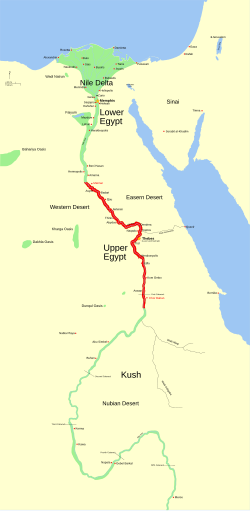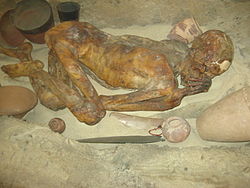涅伽達文化
 涅伽達一期文化的範圍 | |
| 地理範圍 | 埃及 |
|---|---|
| 時期 | 新石器時代 |
| 時間 | 約4000–3000 BC |
| 典型代表 | 涅伽達 |
| 先前文化 | 拜達里文化 |
| 繼承文化 | 埃及第一王朝 |
涅伽達文化(英語:Naqada culture,又譯奈加代文化)是古埃及前王朝時期(約公元前4000—前3000年)的一個考古學文化,該文化的名稱來自於基納省的奈加代。2013年牛津大學對前王朝時期進行的放射性碳測定研究表明,其開始日期大約在公元前3800年至3700年之間。[1]奈加代三期文化是奈加代文化的最後一個階段。
分期
[編輯]
弗林德斯·皮特里爵士
[編輯]1894年,發現這座遺址的弗林德斯·皮特里爵士,最初將涅伽達文化分為三期:
沃納·凱澤
[編輯]沃納·凱澤在1957年提出了一種新的分期方法,該分期始於公元前4000年,現在的版本略有調整如下:[2]
-
涅伽達二期文化的女性雕像。公元前3500年至3400年,現藏於布魯克林博物館
-
前王朝時期的涅伽達烹飪罐。研究表明,這個罐子曾經裝過一份蜂蜜燉肉。
-
涅伽達1419號墓中出土的雕刻河馬牙,上部有四個孔,現藏於倫敦的彼得里埃及考古學博物館。
-
涅伽達1539號墓的斯帕塔(Spatha)貝殼,現藏於倫敦的彼得里埃及考古學博物館。
-
公牛調色板
-
戰鬥調色板,公元前3100年
遺址與考古發掘
[編輯]涅伽達遺址的物質文化根據不同階段而有所變化。在大多數涅伽達遺址中出土的陶器都有其特定時期的特徵。涅伽達遺址出土的陶器類型包括碗、小罐、瓶子、中等大小的頸罐、酒罐和波浪形手柄罐。大多數的出土陶器可能由於裝飾而用於文化用途,同時也用於食物儲存和食物擺放以供食用。陶器上的各種設計包括波浪形圖案,有時伴有花卉圖案或人物繪畫,這表明涅伽達文化的藝術表達十分強烈。 [8] 在涅伽達二期文化的陶器上也描繪了一些動物,如獅身鷹頭獸和蛇頭豹,這些設計可能受到了早期美索不達米亞的影響,與早期烏魯克時期的陶器有關聯。 [9]
-
涅伽達D型陶罐
-
阿姆拉特文化,即涅伽達一期文化的陶罐
-
涅伽達二期文化晚期(公元前3500年-公元前3300年)的陶罐,現藏於大都會藝術博物館
有證據表明,涅伽達三期文化的各個遺址(如塔爾法爾哈,Tel El-Farkha和塔爾穆拉,Tel El-Murra)製造了銅魚叉,主要用於獵捕河馬之類的尼羅河動物。在涅伽達上層社會中,獵捕河馬被認為是高地位的象徵,而銅的獲取更多局限於精英階層,而不是普通百姓。魚叉可能也用於貿易保護。一個古埃及港口的表明,貿易商隊的人們使用魚叉來保護自己。魚叉在藝術表達中也有含義。在宗教儀式中,可能象徵使用魚叉進行一場「魔法」狩獵。 [10] 在涅伽達遺址中發現的小雕像通常由石頭和象牙等材料製成。它們可能用於兒童玩具等日常用途,或者用於藥物和魔法之類的儀式。據推測,有些雕像可能象徵豐饒,用於農業和作物生產。此外,這些雕像還可能在葬禮和安葬儀式中使用。一些遺址中,小雕像常被發現靠近遺體,這表明它們可能在這些儀式中使用。 [11]
刀和刀柄在涅伽達文化中很常見。扭刀傳統是一種可能存在的獨特的刀具傳統,它起源於下埃及,逐漸傳入上埃及,並結合了兩地的刀具製造風格。[12]這個時期發現的刀具由燧石製成。一些年代可以追溯到涅伽達二期文化的刀柄展現了精美的雕刻藝術。刀柄上描繪了宗教信仰和埃及的自然景象。涅伽達社會中使用的刀具常用於日常用途,如切割食物、狩獵和儀式等。通過刀柄上精美的藝術作品,可以推測出這些設計精美的刀柄是為涅伽達社會的上層精英保留的。 [13]涅伽達文化出現了早期埃及文字。文字大約在涅伽達二期文化出現,形式為象形文字。以陶器為主的許多物品寫有文字,這些文字通常描繪動物和人,並用於記錄貿易和行政事務。[13] 文字主要用於精英階層,早期的書寫更多地記錄王室事務,而不是涅伽達文化的日常生活。這一點在前王朝時期和早期王朝時期中也可以見到。[14]
-
涅伽達二期文化的魚尾刀,現藏於大都會藝術博物館
涅伽達遺址發現了許多建築。在埃爾·辛比拉威恩(El-Simbillawein)以東14公里的泰爾·埃爾·法爾哈(Tel-El Farkha)遺址發現了涅伽達二期文化釀酒廠的證據。釀酒廠本身被木柵欄圍繞,將釀酒廠與普通房屋隔開。遺址的發掘顯示,隨著時間的推移木柵欄被泥磚牆所取代。釀酒廠有13個連續的大缸,這些大缸很可能被用來生產啤酒。[15]製作啤酒時,一部分穀物製作成麥芽,另一部分製成粥狀物。然後將兩者混合,通過篩過濾去除液體,最終得到了啤酒。[16]泰爾·埃爾·法爾哈還發現了另一些建築物。其中一座最大的建築建在一個土丘上,由厚泥磚牆包圍,建築內部是保存較差的小房間,四周是30至40厘米高的牆。建築周圍的牆壁可能出於防禦目的而建造。建築物內還發現了一些罐子,表明該建築物也可能被用作倉庫。[15] 在涅伽達一期文化,埃及人與南方的努比亞、西部沙漠的綠洲以及東地中海地區進行了貿易。[17]貿易很可能是由社會精英進行的。[15] 涅伽達文化與下努比亞的人進行貿易,而貿易對象可能是A文化組。涅伽達文化與努比亞人貿易的物質證據可以在這些遺址中的文物中發現。經常交易的商品包括陶器、衣物、調色板和石制容器。努比亞發現的陶器主要出現在墓穴當中,通常在屍體周圍。[8]陶器本身也是從黎凡特交易來的。一件泰爾·埃爾·法爾哈出土的陶器由該地區沒有的粘土製成,推測這件陶器是黎凡特製造和交易而來的。[15]人們還從衣索比亞進口黑曜石,用石片來製作石刃和其它物品。[18]尼肯墓穴中的木炭樣本鑑定為來自黎巴嫩的黎巴嫩雪松,這些墓穴可追溯到涅伽達一期和二期文化。[19]
-
船形調色板,公元前3700年至公元前3600年,涅伽達一期文化,現藏於布魯克林博物館
-
雙頭鳥調色板和魚形調色板,涅伽達二期文化
生物人類學研究
[編輯]
1993年,人類學家C·洛林·布雷斯進行了一項顱面研究並得出結論:「上埃及前王朝時期和下埃及的晚期王朝時期人群彼此之間的關係比與其他任何人群的關係更為密切」,並且在現代人群中與現代埃及人最為相似。報告指出,「自更新世時期以來,埃及人一直存在,基本上未受外侵或遷徙的影響。」對前王朝時期涅伽達人群的顱骨測量分析發現,他們與其他居住在北非並使用亞非語系語言的人群關係密切,包括在非洲之角和馬格里布的部分地區,以及青銅時代和中世紀努比亞人和古代傑里科的樣本。涅伽達人的骨骼在形態上也與來自歐洲和印度次大陸的現代骨骼系列相似,但在表型上與居住在撒哈拉以南非洲和熱帶非洲的尼日-剛果語系人群骨骼,以及瓦迪哈勒法挖掘出的中石器時代骨骼有顯著不同。[20]
2022年,生物人類學家S.O.Y.基塔對布雷斯的研究方法論提出批評。基塔認為布雷斯「誤述了他人工作中使用的典型相關分析和主成分分析的基本假設」。 此外,基塔還指出,1993年的研究忽視了「埃及人也可以與古代努比亞人和現代索馬利亞人這兩個熱帶非洲群體聚類在一起的事實」。[21]
埴原恆彥(Tsunehiko Hanihara)等人在2003年的研究中對全球資料庫中的70個樣本進行了顱骨研究。其中包括來自前王朝時期的涅迦達和第十二至十三王朝時期的克爾瑪,在研究中被統稱為『北非人』;另外還有來自索馬利亞和奈及利亞的其他樣本,被分類為『撒哈拉以南非洲人』,但沒有明確的年代劃分。來自前王朝時期涅迦達,以及之後的克爾瑪的樣本聚類緊密,並與歐洲群體聚類在一起,而撒哈拉以南非洲的其他樣本則顯示出『與其他地區顯著分離,並且它們自身也存在多樣性』。[22]
另一方面,不同的體質人類學研究發現,涅迦達的骨骼遺骸與東北非洲具有生物親緣關係。 On the other hand, various biological anthropological studies have found Naqada skeletal remains to have Northeastern African biological affinities.[23][24]1996年,S.O.Y.基塔測量並描述了53個涅迦達顱骨樣本。他得出結論稱,61%至64%的樣本屬於南部序列(與克爾瑪的庫施人最接近),而36至41%的樣本更類似於北埃及樣本(沿海馬格里布人)。相比之下,拜達里顱骨樣本大多數與上埃及-南部系列相符,比例為90%至100%,另外的9%可能顯示出北部親緣關係。這種變化主要由於北埃及人沿尼羅河谷的本地遷移,或者近東人口的遷移,也可能是可能是兩種人口流動產生的疊加效應,導致了基因交流。中東序列與早期南上埃及人和努比亞人都存在相似性,研究人員認為這可能在一定程度上反映了該族群的真實存在,這一觀點得到了考古和歷史資料的證實。[25]
生物人類學家肖馬爾卡·基塔與A·J·博伊斯指出,「對前王朝時期上埃及(形成期,約公元前4000-3100年)顱骨的研究表明,這些遺骸通常與古努比亞人、庫施人、撒哈拉人以及現代非洲之角族群的顱骨特徵更為接近,而與王朝時期下埃及人或古今南歐人群存在顯著差異。" 兩位學者進一步指出,尼羅河谷早期遺骸的肢體比例更近似熱帶人群特徵。這一發現具有特殊意義,因埃及本身並不位於熱帶地區。研究者據此認為,「埃及尼羅河谷的主體居民並非源自歐洲等地的寒冷適應性人群」。[26]
1996年,洛維爾(Lovell)和普羅斯(Prowse)研究了在涅伽達發現的墓葬人群,這些人被認為埋在高規格的貴族墓葬中,表明他們是涅伽達本地人口中內婚制的統治階層或貴族,他們與努比亞北部(A族群)的人群更為接近,而非與南埃及的鄰近人群。具體而言,作者強調涅伽達的樣本「與下努比亞原始王朝時期樣本的相似度高於與地理上更接近的南埃及的基納和拜達里的樣本」。然而,他們發現涅伽達墓地的骨骼樣本與下努比亞的原始王朝時期人群,以及拜達里和基納的埃及原始王朝時期樣本都有明顯不同(這二者之間也有顯著不同)[27] 總體而言,涅伽達墓地中的貴族和非貴族個體彼此間的相似度,仍高於其與北努比亞的樣本或南埃及的拜達里和基納的樣本。[28]
1999年,洛弗爾綜合現代骨骼研究指出,「總體而言,上埃及與努比亞居民在生物特徵上與撒哈拉及其以南人群呈現出最大的親緣性」,但在非洲地域框架內仍存在局部變異。其研究同時指出,埃及與敘利亞-巴勒斯坦地區的考古及銘文證據「強烈暗示該區域基因流動存在極大的可能性」。[29]
2018年,戈德通過比較18組時空跨度涵蓋下埃及至下努比亞7400年時間的埃及-努比亞顱骨樣本,解析尼羅河谷人群關係。生物距離矩陣顯示,克爾瑪與吉薩,克爾瑪與利什特(Lisht)間存在最小生物距離;最大差異出現在薩亞拉C族群(Sayala C-Group)與泛墓葬樣本、薩亞拉C族群與塞姆納南部的基督教樣本之間[30]。中石器時代組群與埃及涅迦達人群的生物距離小於其與另一努比亞組群(庫魯布納提島)的距離,並與塞姆納南部的努比亞基督教組群趨同。下努比亞北部與上埃及樣本(A族群、C族群、中石器時代、薩亞拉C族群、科普特、赫薩/比加、拜達里及涅迦達)形成聚類;下埃及樣本(吉薩、開羅、利什特)構成相對同質化組群;塞姆納南部(麥羅埃、X族群、基督教)、地理鄰近的庫魯布納提(基督教)、泛墓葬及凱爾邁樣本亦呈現空間聚集。整體數據呈現顯著的南北梯度分布特徵。[31]
2020年,戈德對包含兩組埃及前王朝樣本(拜達里與涅迦達)、努比亞A族群及巴勒斯坦拉基什青銅時代樣本的顱骨序列進行分析。結果顯示:兩個前王朝樣本親緣性最強,其次是涅迦達與努比亞組群。努比亞A族群在分布上更接近埃及樣本,而拉基什樣本與涅迦達的關聯性強於拜達里。戈德運用時空模型解釋生物距離模式,指出拜達里與拉基什的較遠關係源於基因流動的時滯效應:隨時間推移,種群間相似度將逐步提升。總體而言,兩組埃及樣本與努比亞組群的相似度均高於其與拉基什樣本的關聯性。[32]
2023年,克里斯多福·埃雷特指出,「公元前四千年古埃及文明發源地(特別是拜達里與涅迦達)主要墓葬遺址的人類學研究,表明其人群沒有受到黎凡特人群的顯著影響」。其研究揭示這些遺骸的顱齒特徵東北非洲周邊地區的長期定居人口(如努比亞與非洲之角北部)有著最為密切的相似性。埃雷特強調,「這些人口的成員並非來自其他地方,而是這些地區數千年以來原住民的直系後代」。埃雷特還引用現有的考古學、語言學與遺傳學證據構建他的人口史觀點。[33]
涅伽達文化現存的基因數據
[編輯]多位學者著重指出,當前針對埃及木乃伊遺骸開展的DNA研究存在顯著的方法問題造成的局限性。[34][35][33] 基塔與博伊斯(1996年)特別強調,前王朝時期埃及南部的骨骼尚未進行系統化DNA分析。[36] 歷史學家威廉·斯蒂賓與考古學家蘇珊·N·赫爾夫特指出,埃及木乃伊DNA檢測結果的矛盾性,導致學界對古埃及人種遺傳構成及其地理起源難以形成共識。[37]
儘管如此,多項DNA研究表明,基督教時期的努比亞人群、現代努比亞人及非洲之角的亞非語系族群,均為歐亞大陸西部與東非人群混合的後裔。[38][39][40][41]
相關分期
[編輯]參考文獻
[編輯]- ^ Carbon dating shows ancient Egypt's rapid expansion. [2024-02-05]. (原始內容存檔於2024-07-17).
- ^ Hendrickx, Stan. The relative chronology of the Naqada culture: Problems and possibilities. Academia: 64 (英語).
- ^ Shaw, Ian. The Oxford History of Ancient Egypt. Oxford, England: Oxford University Press. 2002: 61. ISBN 0-500-05074-0.
- ^ Barbara G. Aston, James A. Harrell, Ian Shaw (2000). Paul T. Nicholson and Ian Shaw editors. "Stone," in Ancient Egyptian Materials and Technology, Cambridge, 5-77, pp. 46-47. Also note: Barbara G. Aston (1994). "Ancient Egyptian Stone Vessels," Studien zur Archäologie und Geschichte Altägyptens 5, Heidelberg, pp. 23-26. (See on-line posts: [1] and [2].)
- ^ UCLA Encyclopedia of Egyptology (PDF).
- ^ Naqada, ivory carvings. www.ucl.ac.uk.
- ^ Petrie, William Matthew Flinders. Naqada and Ballas. 1895: 213 (英語).
- ^ 8.0 8.1 Takamiya, Izumi H. Egyptian Pottery Distribution in A-Group Cemeteries, Lower Nubia: Towards an Understanding of Exchange Systems between the Naqada Culture and the A-Group Culture. The Journal of Egyptian Archaeology. December 2004, 90 (1): 35–62. ISSN 0307-5133. S2CID 191702457. doi:10.1177/030751330409000103 (英語).
- ^ Joffe, Aleander J. Egypt and Syro-Mesopotamia in the 4th millennium: implications of the new chronology. Current Anthropology. 2000, 1 (41): 113–123. S2CID 11399314. doi:10.1086/300110 –透過University of Chicago Journals.
- ^ Mining for ancient copper. Essays in memory of Beno Rothenberg | WorldCat.org. www.worldcat.org. [2023-02-24] (英語).
- ^ Ordynat, Ryna. Chapter 2:The Study of Predynastic Figurines. Egyptian Predynastic Anthropomorphic Objects: A Study of Their Function and Significance in Predynastic Burial Customs 1. Archaeopress. 2018-03-31: 7–16 (English).
- ^ Śliwa, Joachim. The Nile Delta as a Center of Cultural Interaction Between Upper Egypt and the Southern Levant in the 4th Millennium BC.. Studies in ancient art and civilization 18. Państw. Wydaw. Naukowe. 2014: 25–45. ISBN 978-83-01-10282-1. OCLC 165389017.
- ^ 13.0 13.1 Josephson, Jack A.; Dreyer, Gunter. Naqada IId: The Birth of an Empire Kingship, Writing, Organized Religion. Journal of the American Research Center in Egypt. 2015, 51: 165–178. doi:10.5913/jarce.51.2015.a007 (不活躍 1 November 2024) –透過Academida.edu.
- ^ Bard, Kathryn A. An introduction to the archaeology of Ancient Egypt. John Wiley & Sons. 7 January 2015. ISBN 978-1-118-89611-2. OCLC 1124521578.
- ^ 15.0 15.1 15.2 15.3 Ciałowicz, Krzysztof Marek. New Discoveries at Tell el-Farkha and the Beginnings of the Egyptian State. Études et Travaux. 2017-08-23, (30): 231. ISSN 2449-9579. doi:10.12775/etudtrav.30.011
 .
.
- ^ Adamski, Bartosz; Rosińska-Balik, Karolina. Brewing Technology in Early Egypt. Invention of Upper or Lower Egyptians?. Studies in African Archaeology. 2014, (13): 23–36 –透過ResearchGate.
- ^ Shaw, Ian. The Oxford History of Ancient Egypt. Oxford, England: Oxford University Press. 2002: 61. ISBN 0-500-05074-0.
- ^ Barbara G. Aston, James A. Harrell, Ian Shaw (2000). Paul T. Nicholson and Ian Shaw editors. "Stone," in Ancient Egyptian Materials and Technology, Cambridge, 5-77, pp. 46-47. Also note: Barbara G. Aston (1994). "Ancient Egyptian Stone Vessels", Studien zur Archäologie und Geschichte Altägyptens 5, Heidelberg, pp. 23-26. See on-line posts: [3] and [4].
- ^ Parsons, Marie. Egypt: Hierakonpolis, A Feature Tour Egypt Story. www.touregypt.net. [2008-07-09].
- ^ Brace, C. Loring; et al. Clines and clusters versus "race:" a test in ancient Egypt and the case of a death on the Nile. American Journal of Physical Anthropology. 1993, 36 (S17): 1–31 [1 November 2017]. doi:10.1002/ajpa.1330360603
 .; also cf. Haddow (2012) for similar dental trait analysis
.; also cf. Haddow (2012) for similar dental trait analysis
- ^ Keita, S. O. Y. Ideas about "Race" in Nile Valley Histories: A Consideration of "Racial" Paradigms in Recent Presentations on Nile Valley Africa, from "Black Pharaohs" to Mummy Genomest. Journal of Ancient Egyptian Interconnections. September 2022.
- ^ Hanihara, Tsunehiko; Ishida, Hajime; Dodo, Yukio. Characterization of biological diversity through analysis of discrete cranial traits. American Journal of Physical Anthropology. July 2003, 121 (3): 241–251. PMID 12772212. doi:10.1002/ajpa.10233
 (英語).
(英語).
- ^ "When Mahalanobis D2 was used,the Naqadan and Badarian Predynastic samples exhibited more similarity to Nubian, Tigrean, and some more southern series than to some mid- to late Dynasticseries from northern Egypt (Mukherjee et al., 1955). The Badarian have been found to be very similar to a Kerma sample (Kushite Sudanese), using both the Penrose statistic (Nutter, 1958) and DFA of males alone (Keita,1990). Furthermore, Keita considered that Badarian males had a southern modal phenotype, and that together with a Naqada sample, they formed a southern Egyptian cluster as tropical variants together with a sample from Kerma". Zakrzewski, Sonia R. Population continuity or population change: Formation of the ancient Egyptian state. American Journal of Physical Anthropology. April 2007, 132 (4): 501–509. PMID 17295300. doi:10.1002/ajpa.20569 (英語).
- ^ Godde, K. An examination of Nubian and Egyptian biological distances: support for biological diffusion or in situ development?. Homo: Internationale Zeitschrift für die Vergleichende Forschung am Menschen. 2009, 60 (5): 389–404. ISSN 1618-1301. PMID 19766993. doi:10.1016/j.jchb.2009.08.003.
- ^ Keita, Shomarka. Analysis of Naqada Predynastic Crania: a brief report (1996) (PDF). [2022-02-22]. (原始內容 (PDF)存檔於2022-12-05).
- ^ Keita, Shomarka; Boyce, A.J. "The Geographical Origins and Population Relationships of Early Ancient Egyptians", In Egypt in Africa, Theodore Celenko (ed).. Indiana University Press. December 1996: 20–33. ISBN 978-0-253-33269-1.
- ^ Lovell, Nancy C.; Prowse, Tracy L. Concordance of cranial and dental morphological traits and evidence f.... Archive.ph. 17 December 2012 [16 September 2023]. (原始內容存檔於17 December 2012).
Table 3 presents the MMD date for Badari, Qena, and Nubia in addition to Naqada and shows that these samples are all significantly different from each other. Since the two non-elite samples from Naqada are not significantly different, they were pooled for the cluster analysis that is presented in Figure 2 and which demonstrates that 1) the Naqada samples are more similar to each other than they are to the samples from the neighbouring Upper Egyptian or Lower Nubian sites and 2) the Naqada samples are more similar to the Lower Nubian protodynastic sample than they are to the geographically more proximate Egyptian samples.
- ^ Lovell Nancy and Prowse Tracy. Concordance of cranial and dental morphological traits and evidence f.... Archive.ph. 17 December 2012 [16 September 2023]. (原始內容存檔於17 December 2012).
the Naqada samples are more similar to each other than they are to the samples from the neighbouring Upper Egyptian or Lower Nubian sites
- ^ Lovell, Nancy C. Egyptians, physical anthropology of. Bard, Kathryn A.; Shubert, Steven Blake (編). Encyclopedia of the Archaeology of Ancient Egypt. London: Routledge: 328–331. 1999. ISBN 0-415-18589-0.
- ^ Godde, Kanya. A new analysis interpreting Nilotic relationships and peopling of the Nile Valley. HOMO: Journal of Comparative Human Biology. 2018-07-01, 69 (4): 147–157. PMID 30055809. doi:10.1016/j.jchb.2018.07.002.
- ^ Godde, K. A new analysis interpreting Nilotic relationships and peopling of the Nile Valley. Homo: Internationale Zeitschrift für die Vergleichende Forschung am Menschen. July 2018, 69 (4): 147–157. ISSN 1618-1301. PMID 30055809. S2CID 51865039. doi:10.1016/j.jchb.2018.07.002.
- ^ Godde, Kane. A biological perspective of the relationship between Egypt, Nubia, and the Near East during the Predynastic period (2020). [16 March 2022].
- ^ 33.0 33.1 Ehret, Christopher. Ancient Africa: A Global History, to 300 CE. Princeton: Princeton University Press. 20 June 2023: 83–85, 97. ISBN 978-0-691-24409-9 (英語).
- ^ Eltis, David; Bradley, Keith R.; Perry, Craig; Engerman, Stanley L.; Cartledge, Paul; Richardson, David. The Cambridge World History of Slavery: Volume 2, AD 500-AD 1420. Cambridge University Press. 12 August 2021: 150. ISBN 978-0-521-84067-5 (英語).
- ^ Candelora Danielle; Ben-Marzouk Nadia; Cooney Kathyln (編). Ancient Egyptian society: challenging assumptions, exploring approaches. Abingdon, Oxon: Taylor & Francis. 31 August 2022: 101–122. ISBN 978-0-367-43463-2.
- ^ Celenko, Theodore. "The Geographical Origins and Population Relationships of Early Ancient Egyptians" In Egypt in Africa. Indianapolis, Ind.: Indianapolis Museum of Art. 1996: 20–33. ISBN 0-936260-64-5.
- ^ Jr, William H. Stiebing; Helft, Susan N. Ancient Near Eastern History and Culture. Taylor & Francis. 3 July 2023: 209–212. ISBN 978-1-000-88066-3 (英語).
- ^ Sirak, K.A. Social stratification without genetic differentiation at the site of Kulubnarti in Christian Period Nubia. Nature Communications. 2021, 12 (1): 7283. Bibcode:2021NatCo..12.7283S. PMC 8671435
 . PMID 34907168. doi:10.1038/s41467-021-27356-8.
. PMID 34907168. doi:10.1038/s41467-021-27356-8. We find that the Kulubnarti Nubians were admixed with ~43% Nilotic related ancestry on average (individual proportions varied between ~36-54%) and the remaining ancestry reflecting a West Eurasian-related gene pool ultimately deriving from an ancestry pool like that found in the Bronze and Iron Age Levant. ... The Kulubnarti Nubians on average are shifted slightly toward present-day West Eurasians relative to present-day Nubians, who are estimated to have ~40% West Eurasian-related ancestry.
- ^ Hollfelder, Nina. Northeast African genomic variation shaped by the continuity of indigenous groups and Eurasian migrations. PLOS Genetics. 2017, 13 (8): e1006976. PMC 5587336
 . PMID 28837655. doi:10.1371/journal.pgen.1006976
. PMID 28837655. doi:10.1371/journal.pgen.1006976  .
. All the populations that inhabit the Northeast of Sudan today, including the Nubian, Arab, and Beja groups showed admixture with Eurasian sources and the admixture fractions were very similar. ...Nubians are an admixed group with gene-flow from outside of Africa ... The strongest signal of admixture into Nubian populations came from Eurasian populations and was likely quite extensive: 39.41%-47.73%. ... Nubians can be seen as a group with substantial genetic material relating to Nilotes that later have received much gene-flow from Eurasians.
- ^ Haber, Marc. Chad Genetic Diversity Reveals an African History Marked by Multiple Holocene Eurasian Migrations. American Journal of Human Genetics. 2017, 99 (6): 1316–1324. PMC 5142112
 . PMID 27889059. doi:10.1016/j.ajhg.2016.10.012.
. PMID 27889059. doi:10.1016/j.ajhg.2016.10.012. We found that most Ethiopians are a mixture of Africans and Eurasians. ... Eurasian ancestry in Ethiopians ranges from 11%–12% in the Gumuz to 53%–57% in the Amhara.
- ^ Ali, A. A. Genome-wide analyses disclose the distinctive HLA architecture and the pharmacogenetic landscape of the Somali population. Scientific Reports. 2020, 10 (6): 1316–1324. Bibcode:2020NatSR..10.5652A. PMC 5142112
 . PMID 27889059. doi:10.1038/s41598-020-62645-0.
. PMID 27889059. doi:10.1038/s41598-020-62645-0. Principal component analysis showed approximately 60% East African and 40% West Eurasian genes in the Somali population, with a close relation to the Cushitic and Semitic speaking Ethiopian populations.







![涅伽達的前王朝時期人物雕像。[5][6][7]](http://upload.wikimedia.org/wikipedia/commons/thumb/4/48/Predynastic_human_figures.jpg/120px-Predynastic_human_figures.jpg)









